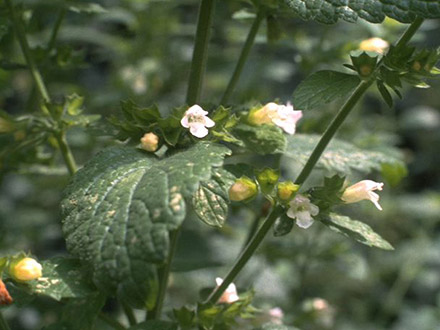Botanical name
Melissa officinalis L.
Family
Lamiaceae
Common name
Lemon balm, Common balm, Garden balm, Melissa, Sweet balm, Bee balm
Information about the plant
Lemon balm was originally native to Asia Minor and Southwest Siberia. Today, it is cultivated in Central Europe and occasionally found growing wild. It attracts bees, which is reflected in the genus name (Greek "melissa" = bee), and can also be associated with the pleasant scent of honey (Greek "meli" = honey). The species epithet officinalis suggests that it is an old medicinal plant because the "officina" is the salesroom of a pharmacy, and "officinalis" means commonly used in the pharmacy.
Lemon balm is a shrub that grows up to 80 cm tall with branched, angular stems. The stalked, broadly ovate leaves are opposite on the stem and have serrated margins. The lemon-like smell of the leaves comes from an essential oil, which is contained in the glandular scales on the leaf surface. These glands are damaged when rubbed, releasing the essential oil. There are several pale-white flowers in the leaf axils of the upper leaves, which have a strikingly large lower lip and double lip cup. The flowering period is June to August.
Medicinally used parts of plants (herbal drug)
The leaves (Melissae folium) are used with their typical lemon-like scent, which is clearly perceived when rubbed. The commercially available drug comes from cultivations across Central, Western and Eastern Europe.
Constituents of the herbal drug
Lemon balm leaves contain an essential oil mainly composed of citral and citronella, which are responsible for the lemon-like aroma, as well as lamiaceous tannins (main representative: rosmarinic acid) and flavonoids.
Quality of the drug
The quality of the following drugs or drug preparations is specified in the European Pharmacopoeia (Ph. Eur.):
- Lemon balm leaves (Melissae folium)
- Lemon balm leaves dried extract (Melissae folii extractum siccum)
Medical applications
Recognised medical use
The HMPC has classified lemon balm leaves as a traditional herbal medicinal product (see "Traditional use").
Indications supported by clinical data (approval): externally for herpes infections (cold sores caused by herpes simplex HSV-1 and HSV-2)
ESCOP: internally for anxiety, restlessness, and irritability, and for the symptomatic treatment of digestive complaints such as mild abdominal cramps; externally for the treatment of cold sores (herpes labialis).
Traditional use
The HMPC has classified lemon balm leaves as a traditional herbal medicinal product (Article 16a of Directive 2001/83/EC). Based upon long-standing use, lemon balm leaves can be used to reduce mild stress symptoms and as a sleep aid, as well as for mild cramp-like gastrointestinal complaints (bloating, flatulence).
Herbal drug preparations in finished dosage forms
- Lemon balm leaves as a tea
- Fluid extract in liquids
- Alcoholic extracts in drops
- Dried extract in soluble teas, tablets, coated tablets
- Dried extract in ointments (for cold sores)
- In oral preparations, lemon balm leaves are often combined with other sedative drugs.
Dosage
Finished medicinal product: see patient information leaflet.
Tea: drink 1 cup of freshly prepared lemon balm tea warm, several times a day.
External use for cold sores: creams are available in the form of ready-to-use medicines; see patient information leaflet for dosage.
Preparation of a tea
Pour 150 mL of hot water over 1.5 to 4.5 g of finely chopped lemon balm leaves (do not boil!), leave to infuse for 5 to 15 minutes and strain.
Notes
Lemon balm preparations must be avoided in the case of known allergies to lemon balm; no safety studies are yet available on the use of lemon balm leaves during pregnancy and lactation; use in children under 12 years of age is not recommended due to a lack of evidence.
Side effects
None known.
Interactions
None known.


